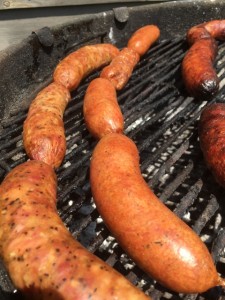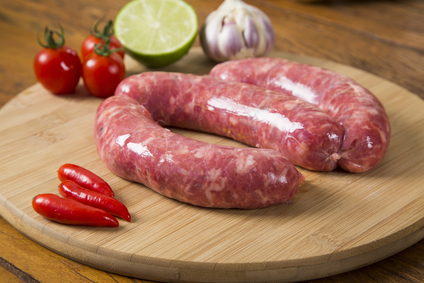We’re pretty link-happy at Sap Bush Hollow Farm. We produce a wide variety of sausage, from Bratwurst to breakfast, from andouille to apple, from Sicily to Tuscany, because, well, they’re just so darned tasty off the grill. We’ve spent a lot of hours blending, linking and cooking these wonders and, naturally, we have a few opinions about how good-quality artisan farm-fresh sausages should be handled.
Don’t pierce your sausages.While factory-made sausages are often a mechanism for disposing of lower-quality meat and large volumes of fat, the opposite is true on the farm. Many farmers dedicate high-quality, meaty primals to the sausage cause, including the legs and shoulders of the pig. While typical grocery store sausages might contain 35-50 percent fat, very often farm sausages are about 20 percent fat, the same as a good quality hamburger (breakfast sausages, however, traditionally have a higher fat content). While all the fun spices are what characterize different sausage varieties, what makes these natural casing-wrapped links particularly special is the cooking process. When the meat and fats and spices are all wrapped up in a casing and exposed to heat, the fats melt and bubble, braising the meat and spices, creating the flavor profile. Those unfortunate fat-fearing folks who prick the links to drain them are undermining all the wizardry that went into creating these little wonders. Furthermore, to add even more flair, many artisan sausage makers will add different liquids to their blends, such as beer, broth, or wine. Like the fats, these liquids serve to braise the meat in the casing. Pricking the skins of the sausages will only result in the loss of these tasty fluids, producing a dry, mealy sausage.
Be gentle with your little links. A typical asado (grilled dinner) in Argentina is often preceded first by a sausage course. Sweet links are removed from the grill and served plain in crusty bread, making a delightful sandwich called chori-pan. To prepare them, they are first hung on the hearth a good distance from the flames and embers, where they warm slowly. Over the course of about 90 minutes, they are progressively moved closer to the intense heat, allowing the fats and liquids in the casing to slowly melt and bubble, braising the meat gently and giving the seasonings plenty of time to incorporate into the cooked morsels. By the time the sausages are removed from the grill, the casings are crisp and taught with nary a burn mark. The meat is perfectly cooked and juicy, and not a single sausage has exploded. By contrast, in the US, I’ve seen many backyard grillers toss the links directly onto the flames, allowing them to blacken or burst in the intense heat as the fats and fluids come to a rapid boil, all in the course of a few minutes. 
While it may not be necessary to cook your links for a full hour and a half, do consider moderating the flame and allowing the meat to come up to temperature by indirect cooking instead, cooking them gently for about 25-30 minutes. You’ll likely find the meat tastier and juicier, and the casing much snappier.

Can’t wait to teach my kiddie cooks to be kinder to the links so they are kinder to our buds.